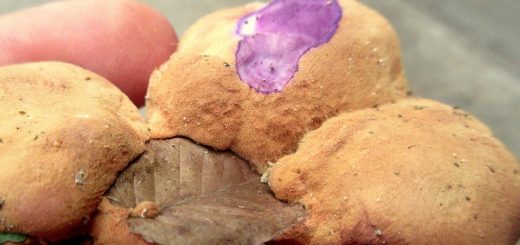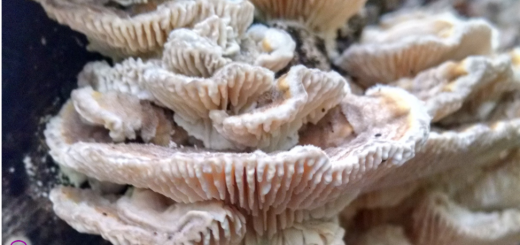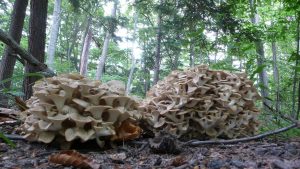#114: Hericium erinaceus, the Lion’s Mane, Bearded Tooth, or Pom Pom Blanc Mushroom
This edible, toothed mushroom looks like a frozen waterfall sprouting out of the side of a tree. Aside from its unique appearance, the mushroom is notable for its putative ability to help the nervous system regenerate.
Hericium erinaceus has received a number of common names to try and describe this rather unusual appearance. The two most popular among English-speaking countries are “Lion’s Mane,” which is most prevalent in the United States, and “Bearded Tooth,” which is commonly used in the British Isles. Additionally, it is often sold as “Pom Pom Blanc.” Wikipedia lists a number of variations on these names: “Satyr’s Beard,” “Bearded Hedgehog Mushroom,” “Pom Pom Mushroom,” and “Bearded Tooth Fungus.” In Chinese, it is called “hóu tóu gū,” which translates to “Monkey Head Mushroom.” This translation is used as a common name for H. erinaceus by some English sources. The mushroom’s Japanese name is “yamabushitake,” which means “Mountain Priest Mushroom.” Most of the scientific research into this mushroom has been carried out by Japanese scientists, so this name is commonly found in scientific papers. Its scientific name is rather boring: Hericium means “hedgehog-like” and erinaceus is just a different way of saying “hedgehog-like.”
The Lion’s Mane is a very unusual but gorgeous mushroom. The fruiting bodies are white, medium-sized to large (8-40cm or about 3-16in in diameter), roughly spherical, and composed of long spines. Each spine is white, 1-6cm (about 0.5-2.5in) long, soft, and somewhat bendable. The spines discolor yellowish or brownish in age, especially at the tips. As in other toothed fungi, the spines are arranged perpendicular to the ground so that spores can easily drop into air currents. H. erinaceus has some of the longest spines among the toothed fungi and even among the other members of its genus (Hericium). The spines hide a supporting base that attaches the mushroom to its substrate and gives the mushroom its shape. The base is an unbranched structure, so the overall shape of the mushroom is roughly spherical. This feature separates the Lion’s Mane from other Hericium species. The top of the mushroom is composed of small, disorganized spines, so it looks a bit like spaghetti or partially melted, grated cheese. Sometimes the spines on the top are more organized and all point the same direction.
H. erinaceus is parasitic and saprobic on trees, so it can be found growing from wounds on living trees and sometimes on fallen logs. The Lion’s Mane prefers oaks and beeches, but can be found on a variety of hardwoods. It decomposes the wood at the center of its host tree, so it will not form fruiting bodies unless it can find a path to the surface. Wounds or places where branches have fallen off provide an easy route through the bark, so the Lion’s Mane is often found growing in such places. H. erinaceus fruits in late summer and fall and can usually be found in the same place year after year. This fungus is distributed all across the northern temperate zones and can be found in North America, Europe, and Asia.
There are a few species that are similar to H. erinaceus. All of these have branched bases and/or shorter spines. However, it is not always easy to tell them apart based solely on those features. Young Hericium species are often indistinguishable from one another because spines have not yet elongated and branching has not yet developed. If you want to accurately identify your collection, you have to make sure the mushroom is mature (it should have yellowing tips). Even then it can be difficult to tell them apart. The North American mushroom which most closely resembles the Lion’s Mane is H. americanum. This mushroom has spines that are about the same length as those of the Lion’s Mane, but H. americanum should be branched. Sometimes, however, it does not branch. Fortunately for the mushroom hunter, all species in the genus Hericium are edible, so identification down to species is not necessary.
DNA evidence has shown that the genus Hericium is not closely related to most other toothed fungi. Most mushrooms with teeth – such as Hydnum repandum, the Hedgehog Mushroom – are placed in the order Cantharellales, which also contains most chanterelles. It turns out that Hericium belongs in the order Russulales. This order contains russulas (which are gilled fungi unrelated to the majority of gilled fungi), mycorrhizal polypores, and crust fungi. In full, H. erinaceus belongs to the phylum Basidiomycota, class Agaricomycetes, order Russulales, family Hericiaceae, and genus Hericium.
As mentioned above, the Lion’s Mane is an edible mushroom! It has an interesting flavor, somewhat like that of lobster, shrimp, fish, or tender meat. Because of its mild but interesting flavor, it can be featured in a main dish or used as a component in soups and stews. Wild Lion’s Mane is best before its teeth start to turn yellow, as it may develop a bitter flavor with age. The only time I found this mushroom it was on the ground. It had obviously fallen off the nearby tree, which (in addition to the yellowing tips) indicated that it was too old to eat. Still, this ranks as one of my favorite mushroom finds because of the mushroom’s beauty and because I wasn’t expecting to see any interesting mushrooms at night. As a side note, this mushroom is rare in Britain, where it is illegal to remove this species from its native habitat. Fortunately, the Lion’s Mane is very easy to cultivate. It readily grows on and produces mushrooms from bags of sterilized sawdust. As a result, H. erinaceus is widely available in Asian markets and from online sources (which sell growing kits, mushrooms, and extracts in both liquid and pill form).
A number of Japanese studies have shown that H. erinaceus has some rather unusual medicinal properties. A 1991 study by Dr. Kawagishi demonstrated that H. erinaceus contains chemicals that can act as nerve growth factors. Further studies showed that there were two new types of NGFs present in Yamabushitake, which were named “hericenones” and “erinacines” after the organism in which they were found. Later studies focused on the potential benefits of these compounds. Various small-scale clinical trials in humans have suggested Yamabushitake has a positive impact on cognitive ability, memory, mood, and concentration. Extracts from the mushroom have been shown to help repair damaged neurons and reduce the symptoms of Alzheimer’s disease (in mice used to model that disease, anyway). This research has not made the mushroom viable for use in modern medicine, but it does show potential for further development. These studies do, however lend support for the mushroom’s use in alternative medicine. Even if the mushroom does not cure any diseases, it will at least taste good!
See Further:
http://www.mushroomexpert.com/hericium_erinaceus.html
http://www.huffingtonpost.com/paul-stamets/mushroom-memory_b_1725583.html (article by Paul Stamets, one of the most vocal and well-respected mycologists of our time)
http://www.mykoweb.com/CAF/species/Hericium_erinaceus.html
http://www.kew.org/science-conservation/plants-fungi/hericium-erinaceus-bearded-tooth









![#011: Characteristics of Kingdom Fungi [Archived]](https://www.fungusfactfriday.com/wp-content/themes/hueman/assets/front/img/thumb-small-empty.png)


Good information for everyone since we all have a brain.